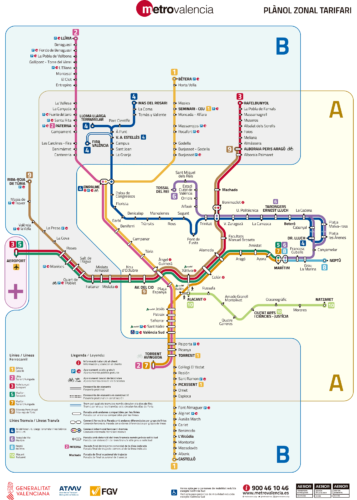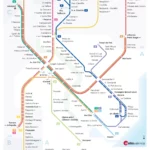The Valencia metro, locally known as Metrovalencia, It is the urban transport system of Valencia (Spain) and was inaugurated in 1988.
Currently holds 9 lines, including 4 subway lines and 5 tram lines, that together they make a journey of about 156 kilometres. Total, hay 137 stations that help connect both the city center and its periphery.
Below we show you the Valencia metro map. Click on the image to see it larger:

Valencia metro schedules
The metro has the following schedules:
- Monday to Thursday: 06:00 a 22:00 hours.
- Friday, Saturdays and the eve of holidays: 06:00 a 03:00 hours.
- Sundays: 07:00 a 22:00 hours.
These times may vary slightly depending on the line and station..
Metro fares
Next, We present a table with the main prices of the Valencia metro for 2024, with the cost in euros and its equivalent in US dollars, so that tourists can get a better idea of the price:
| Type of ticket | Precio (EUR) | Precio (USD) |
|---|---|---|
| One-way ticket | ||
| A zone | 1,50 € | 1,65 USD |
| Two zones | 2,10 € | 2,31 USD |
| Three zones | 2,80 € | 3,08 USD |
| Four zones | 3,90 € | 4,29 USD |
| SUMA 10 | ||
| A zone (10 trips) | 8,00 € | 8,80 USD |
| Two zones (10 trips) | 12,00 € | 13,20 USD |
| Three zones (10 trips) | 20,00 € | 22,00 USD |
| Four zones (10 trips) | 30,00 € | 33,00 USD |
| SUMA 10 Monthly | ||
| A zone | 14,85 € | 16,34 USD |
| Two zones | 22,50 € | 24,75 USD |
| Three zones | 30,00 € | 33,00 USD |
| Four zones | 41,80 € | 46,00 USD |
| Special cards | ||
| TuiN (Wallet card) | 0,72 €/trip | 0,79 USD |
| Youth Card | Free | N/A |
| Gent Major (monthly) | 4,85 € | 5,35 USD |
| Mobilitat (monthly) | 4,85 € | 5,35 USD |
| Mobilitat (Yearly) | 87,30 € | 96,03 USD |
Special Cards and Discounts
- València Tourist Card: This card offers unlimited free bus travel, metro, tram and commuter trains within Valencia by 24, 48 o 72 hours. Besides, allows free entry to municipal museums and monuments and offers discounts of up to 50% in the main tourist attractions of the city, as the City of Arts and Sciences, he Oceanogràfic and the Bioparc.
Official Web site
- For more information, You can visit the official website of the Valencia metro: metrovalencia.es
- To see a list of Valencia attractions, passes and excursions: tiqets.com
History of the Valencia metro
The Valencia metro began its modern history in 1988, but its roots go back much further. This system originated from the ancient “trenet” narrow gauge, a network of railways that connected Valencia with various nearby towns since the end of the 19th century. The company Ferrocarrils de la Generalitat Valenciana (FGV) was in charge of modernizing and transforming this network into the current metro.
The 8 October 1988 the first metro line was inaugurated, the line 1, that connected Llíria con València Sud. This was a significant milestone, since it involved the transformation of the old train line into a modern metro system. The construction included a tunnel from the station Empalme to the station Jesús, allowing a direct link through the city center.
In 1994, Valencia introduced the first modern tram in Spain. This tram was developed from the reorganization of the Line's itineraries 1 and became the Line 4, which is still operational today.
The line 4 was inaugurated in 1999, Connecting Mas del Rosari y Doctor Lluch. This tram, which went through various modifications, was developed to improve access to important urban areas and facilitate mobility in the region.
XXI century
In between 2003 y 2007, The Valencia metro underwent several important expansions. In 2003, The line was inaugurated 5, that links Marítim Serrería with the airport. This section was extended in 2007, facilitating direct access from the port to the airport. The line 7 also opened in 2004, Connecting Marítim Serrería con Torrent Avinguda, and the line 8, a tram line, started operating in 2007.
In March 2015, The line was inaugurated 9, what CONECT Alboraya Peris Aragó con Riba-roja de Túria. This line took advantage of the route of an old railway and improved the connection with important suburban areas.
The last Valencia metro station inaugurated is “Ciutat Arts i Ciències-Justícia” On the line 10. This station is part of a series of new stations opened on 17 May 2022.
History of the Valencia metro map
The first Valencia metro map was developed by Ferrocarrils de la Generalitat Valenciana (FGV). This initial map reflected the connection between Llíria y València Sud through the new tunnel that linked the stations Empalme y Jesús, marking the beginning of a new era in the city's urban transportation. In this period, The initial designs of the map were carried out by Ferrocarrils de la Generalitat Valenciana (FGV), although the specific names of the designers are not detailed.
In the decade of the 90 and the first years of 2000, The map layout was updated to include the Line 3 (Rafelbunyol – Aeroport) and the line 5 (Marítim – Aeroport), among other. The line 4, inaugurated in 1999, introduced the modern tram concept, which was also reflected in the revised versions of the map.
In 2007, with the inauguration of new stations and the line 6, Major modifications were made to the map to improve readability and navigation.
From the year 2015, The map has continued to evolve with the addition of the Line 9 and the expected Line 10. No data was found on designers or companies that updated the map in these years, which suggests that these tasks could have been internally managed by FGV.
Extra map data
We have found that the company estudiorooom.com claims to have designed the Valencia metro map. But there is no data on specific dates, no names of designers.
We have also found a version “not official” from the Valencia metro map 2023, which is very beautiful on a graphic level, made by him designer Tom Göpel and the map is posted on the website of our beloved friends at transitmap.net. The problem is that the map does not coincide with the geographical area of Valencia, and it is strange for Valencians.

Additional data
The Valencia metro facilitates access to important points of interest, These are the most visited sites in the city.
- Ciudad de las Artes y las Ciencias (Alameda, Line 3): Architectural and cultural complex with museums and spaces for entertainment.
- Oceanogràfic (Alameda, Line 3): The largest aquarium in Europe, with marine ecosystems from around the world.
- Valencia Cathedral (Xàtiva, Line 3): Imposing Gothic cathedral that houses the Holy Chalice and offers views from the Miguelete.
- Central Market (Xàtiva, Line 3): Modernist market with fresh and local products, in an emblematic building.
- Garden of Turia (Turia, Line 1): urban park of 9 km that crosses the city, ideal for walks and outdoor activities.
- The Silk Exchange (Xàtiva, Line 3): Gothic building from the 15th century, old silk market and World Heritage Site.
- Serranos Towers (Pont de Fusta, Line 4): Old defense towers with panoramic views of the city.
- Biopark (Nou d’Octubre, Line 3): Immersion zoo that recreates African habitats and houses various species.